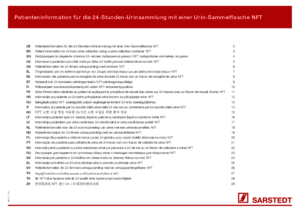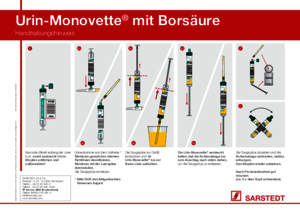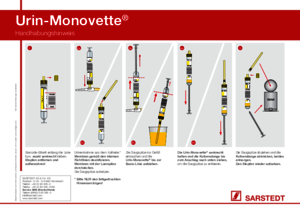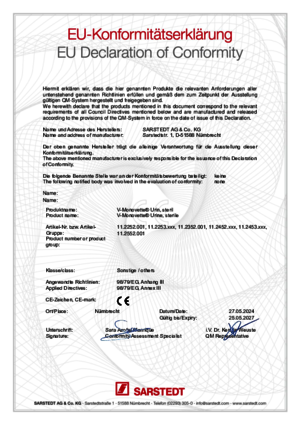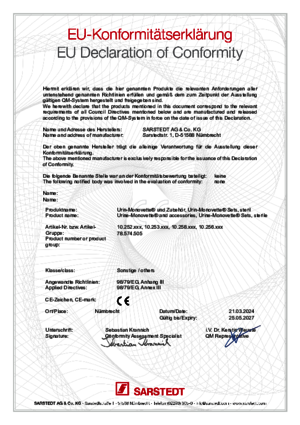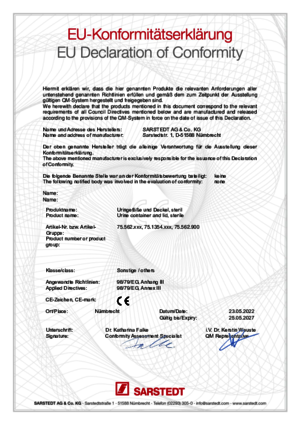
NFT Urine collection system
NFT Urine collection system
Language:

| Order number | 10.252.011 |
|---|---|
| Product description | Urine Monovette®, nominal volume: 10 ml, without preparation, Urine tube, (LxØ): 102 x 15 mm, transparent, graduated, material: PP, Luer screw cap, cap blue, incl. collection tip, with plastic label, 64 piece(s)/bag |
| Type of collection | Aspiration |
|---|---|
| Type of preparation | without preparation |
| Label/ Print | with plastic label |
| Colour of print/label | yellow |
| Graduation | yes |
| Cap | Luer screw cap |
| Closure type | screw cap |
| Light protection | no |
| Application | Urine tube |
| Example of use | Urine collection, transport, and storage |
| Base shape | round base |
| Volume of work | 10 ml |
| Recommended centrifugation | 400 x g |
| Centrifugation time | 5 Min |
| Connection | Luer (m) |
| Sample volume | 10 ml |
|---|---|
| Diameter | 15 mm |
| Length including cap | 117 mm |
| Length excluding cap | 102 mm |
| Length including cap and plunger | 127 mm |
| Product material | Polypropylene (PP) |
|---|---|
| Colour of product | transparent |
| Closure material | High Density Polyethylene (HD-PE) |
| Colour of cap | blue |
| Tube material | Polypropylene (PP) |
| Piston material | High Density Polyethylene (HD-PE) |
| Piston plunger material | Polystyrene (PS) |
| Satisfies the requirement | IATA, ADR |
|---|---|
| Product category | In vitrodiagnostic device, CE |
| CE certified | CE |
| Batched | yes |
| Minimum order qty. | 512 |
|---|---|
| Type of smallest subpackaging | bag |
| Piece(s) / inner box | 64 |
| Piece (s) / outer case | 512 |
| Piece(s) / pallet | 24576 |
| Depth of case | 388 mm |
| Width of case | 378 mm |
| Height of case | 215 mm |
| Case volume | 0.0315 cbm |
| Weight of product | 0.0085 kg |
| Weight of case | 4.85 kg |
| EAN of inner box | 4038917279956 |
| EAN case | 4038917279826 |

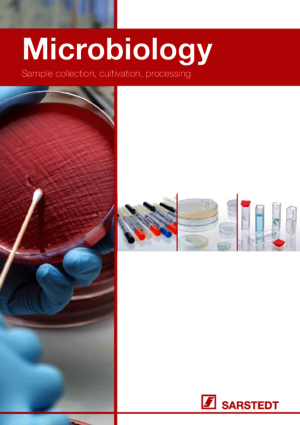
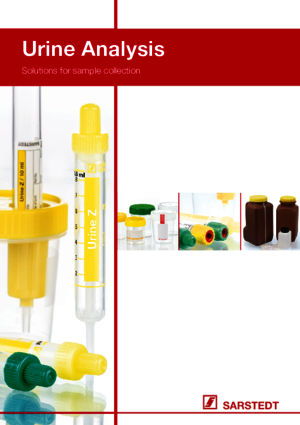
The Urine Monovette® with boric acid stabilises the microorganisms in urine.
In principle, the parameters of urine sediment are affected by the pH value and the specific weight. The use of boric acid can therefore lead to cell lysis. The yellow Urine Monovette® without stabiliser is perfect for determining urine sediment.
The colour-coding of the Urine Monovette makes it easy to quickly distinguish between the version with and without the stabiliser (boric acid).
Yellow: neutral
Green: with boric acid
The Urine Monovette® is prepared with 15 mg boric acid/ml urine. This corresponds to a concentration of 1.5%. The preparation is free from mercury.
The Urine Monovette® 10 ml (product no 10.252) is suitable for urine analyses using test strips. The length of conventional test strips fits perfectly into a filled Urine Monovette®.
The Urine Monovette® tube is made from PP (polypropylene).
Due to the intended purpose, sterility is not required. For special requirements, the following individually packaged sterile Urine Monovettes can be ordered:
Art. No 10.258.020 Urine Monovette® 8.5 ml (92 x 15 mm)
Art. No. 10.252.020 Urine Monovette® 10 ml (102 x 15 mm)
Art. No. 10.253.020 Urine Monovette® with stabiliser 10 ml (102 x 15 mm)
No, if sterile transfer of the sample is required, the urine cup with integrated sterile transfer device can be used (Art. No. 75.562.400).
As the Urine Monovette® with boric acid should always be filled up to the nominal volume, a scale is not required. The filling level mark indicates the correct volume.
It must be assumed that the low pH-value will affect the test methods by providing false measurement results, as most methods involve enzymatic colorimetric tests.
You can also obtain detailed information and any approvals regarding individual parameters from the manufacturer of the reagents.
The Urine Monovette® with boric acid should always be filled up to nominal volume. For optimal stabilisation of microorganisms, underfilling should be avoided.
At the correct filling volume, the boric acid stabilises microorganisms effectively between collection and analysis for up to 48 hours at room temperature.
The recommended centrifugation conditions for sedimentation are 400 x g, 5 minutes at 20°C.
24-hour urine collection eliminates concentration fluctuations occurring throughout the day. It is therefore suitable for safely and reliably determining parameters which are subject to concentration fluctuations (circardian rhythm), such as catecholamine or creatinine clearance.
Collecting 24-hour urine starts by emptying the bladder in the lavatory. This time must be noted (e.g. 7 a.m.).
The next bladder emptying must be transferred to the collection container and, if necessary, the stabiliser is added (do not forget to mix).
Each subsequent urination must be collected until the following day. The collection stops from the time that was noted on the previous day (e.g. 7 a.m.). The bladder should be emptied shortly before in order to add this sample to the amount collected.
Mid-stream urine is particularly important for microbiological tests.
After cleaning the external genitalia and after urinating for approximately 3 seconds, about 10–20 ml of urine is collected in a sterile container without interrupting the urine stream. Impurities are avoided in this way. Once the designated sample volume has been collected, the remaining urine can be released into the lavatory.
We would like to show you additional content which is hosted by a third party. For this purpose we need your consent to set cookies:
